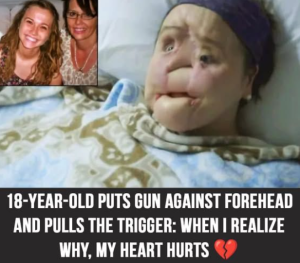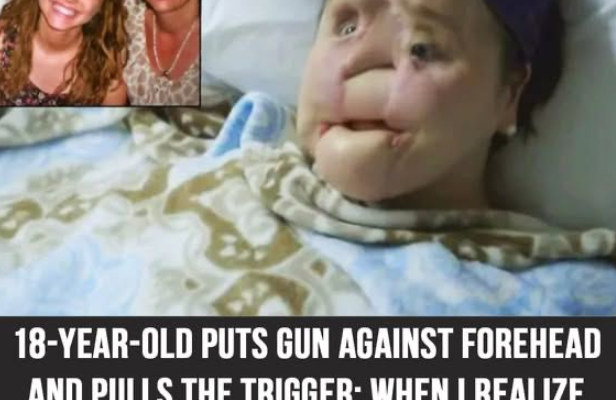The Amazing Story of Katie Stubblefield: The Youngest Face Transplant Recipient in the U.S.
On March 25, 2014, a devastating moment changed the life of 18-year-old Katie Stubblefield forever. A single, impulsive decision — a self-inflicted gunshot to the face — would launch Katie into a years-long journey of pain, resilience, and one of the most groundbreaking surgeries in medical history: a full face transplant. She would go on to become the youngest person in the United States to receive the procedure — a feat that would make headlines and inspire millions around the world.
A Split-Second Decision That Altered Everything
Katie grew up in Mississippi in a tight-knit family that moved around due to her father’s job as a teacher and minister. By all accounts, she was bright, kind, and full of potential. But like many teenagers, she wrestled with emotional struggles that were compounded by life events — health issues, a breakup, and the pressure of academics.
On that fateful day in 2014, after reading text messages that hinted her boyfriend was talking to another girl, Katie ran into the bathroom of her brother’s house, grabbed his hunting rifle, and attempted to take her own life. But the bullet didn’t kill her. Instead, it tore through her forehead, nose, sinuses, and jaw, shattering most of her face and leaving her clinging to life.
She was rushed to a local hospital, then flown to the Cleveland Clinic in Ohio, where a team of trauma and reconstructive surgeons began the long process of trying to save and rebuild her face.
Surviving the Unthinkable
Katie’s survival was nothing short of miraculous. Most people do not live after such a severe injury. She underwent dozens of surgeries — over 20 in the first few years — including jaw reconstruction, tissue grafts, and bone repair. Doctors rebuilt her forehead using bone from her leg and tried to piece together her shattered features, but it was clear that conventional surgery could only go so far.
Her face was so damaged that even eating, breathing, and speaking became monumental challenges. She required a feeding tube and a tracheostomy. Looking into a mirror was heartbreaking. Despite this, Katie was determined to live and rebuild her life. She began working with physical and occupational therapists and re-engaging with her education — all while remaining on a waiting list for a face transplant.
Hope Through the Gift of Donation
In 2017, after three years of waiting, a match was found: Adrea Schneider, a 31-year-old woman who had died of a drug overdose, had chosen to become an organ donor. Her family agreed to donate her face for Katie’s transplant — a decision made in their darkest hour, but one that would give Katie a second chance at life.
Face transplants are among the most complex surgeries in existence. Only a handful of them have ever been done worldwide. The Cleveland Clinic team had to meticulously plan the operation using virtual surgical simulations and 3D-printed models of Katie’s skull.
The Historic Surgery
In May 2017, Katie underwent the 31-hour transplant surgery. A team of over 30 specialists — surgeons, anesthesiologists, nurses, and technicians — worked together to remove what remained of Katie’s damaged face and replace it with the donor tissue.
The transplant included not just skin, but also muscles, blood vessels, nerves, and bones — from the scalp down to the jaw and parts of the neck. The surgeons had to reconnect blood vessels less than a millimeter in diameter and delicately attach nerves in the hope that they would regenerate and restore sensation and movement.
After the surgery, Katie was closely monitored in the ICU for signs of rejection, infection, or complications. She would require lifelong immunosuppressant drugs to prevent her body from rejecting the new tissue.
A New Face, A New Life
The results were astonishing. Katie had a new face — one that looked natural, healthy, and complete. More importantly, she began to regain functions that had been impossible before. She could breathe through her nose, eat solid food again, and express herself with facial gestures. Over time, she started regaining sensation and movement in her face — tiny milestones that meant the world.
Emotionally, the journey was just as intense. Katie struggled with feelings of guilt, especially toward her family and her donor’s loved ones. But with therapy, support from her parents Robb and Alesia, and her own resilience, she began to find a renewed sense of purpose.
From Tragedy to Advocacy
Katie’s story caught the attention of National Geographic, who documented her journey in a 2018 feature called “The Story of a Face.” The in-depth article and accompanying photographs by Maggie Steber and Lynn Johnson brought global attention to face transplants, mental health, and organ donation. Katie bravely allowed her story and appearance to be shared with the world, hoping it would help others avoid the pain she endured.
She has since become an advocate for suicide prevention, mental health awareness, and the importance of organ donation. Katie has spoken to audiences, appeared on national television, and even returned to school, working toward a degree and a future in counseling.
The Cost of Survival
Katie’s journey, while inspiring, has not been easy. She continues to face medical challenges, including the risks that come with immunosuppressive drugs and the possibility of tissue rejection. She will require ongoing surgeries and checkups for the rest of her life.
But Katie doesn’t view her life through the lens of tragedy anymore. She talks about gratitude — for her parents, her doctors, her donor, and even for her second chance at life. She has made peace with the past and is determined to use her experience to help others see that even in the darkest moment, there is always hope.
Conclusion
Katie Stubblefield’s story is a breathtaking testament to human resilience, family devotion, and medical innovation. It’s about what happens after the unthinkable — how science, love, and sheer determination can pull someone back from the brink and give them not just a new face, but a renewed sense of self.
In a world where mental health struggles are too often hidden, Katie’s courage to share her scars — both visible and invisible — is a beacon for others who are suffering. Her story reminds us that no matter how broken life may seem, healing is possible, help is available, and even the most shattered lives can be rebuilt — one step, one surgery, one brave breath at a time.


